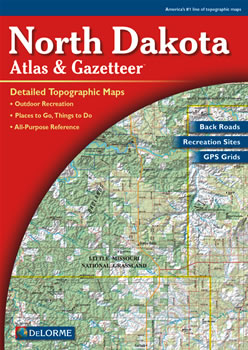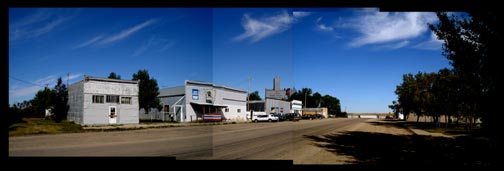Blue Highways: Fortuna, North Dakota
Unfolding the Map
 We have crossed into North Dakota with William Least Heat-Moon, who remarks on the glacial moraine that makes up North Dakota's vast plain. We'll look at the changing climate that may make Ice Ages inconceivable in the future, and then we'll move on. To locate Fortuna, slowly, glacially, find the map.
We have crossed into North Dakota with William Least Heat-Moon, who remarks on the glacial moraine that makes up North Dakota's vast plain. We'll look at the changing climate that may make Ice Ages inconceivable in the future, and then we'll move on. To locate Fortuna, slowly, glacially, find the map.
Book Quote
"East of Fortuna, North Dakota, just eight miles south of Saskatchewan, the high moraine wheat fields took up the whole landscape. There was nothing else, except piles of stones like Viking burial mounds at the verges of tracts and big rock-pickers running steely fingers through the glacial soil to glean stone that freezes had heaved to the surface; behind the machines, the fields looked vacuumed. At a filling station, a man who long had farmed the moraine said the great ice sheets had gone away only to get more rock. 'They'll be back. They always come back. What's to stop them?'"
Blue Highways: Part 7, Chapter 7
 Downtown Fortuna, North Dakota. Photo by David Michael Kennedy at his blog. Click on photo to go to host site.
Downtown Fortuna, North Dakota. Photo by David Michael Kennedy at his blog. Click on photo to go to host site.
Fortuna, North Dakota
At one point, back when the book was recounting LHM's trip through Montana, I commented on the glacial forces that created many of that state's features. No less true is the glacial forces on North Dakota. In the last glacial period, most of North Dakota was covered with up to two miles of ice which leveled its surface and pushed around the rock that LHM comments on in his quote above. Once the ice had scraped the surface flat, warming periods led to the retraction of the glaciers north, and a vast lake, the combined volume of which was more than all the current Great Lakes combined, covered much of central North America. Labeled Lake Agassiz, this tremendous accumulation of fresh water waxed and waned as the glaciers did their dance of advance and retreat. Finally, in the final retreat, Lake Agassiz broke its barriers and drained into Hudson Bay, the Arctic Ocean and down through the North American river systems, creating many natural formations that we see today. The remnants of the colossal ice sheet that covered North America can be found in the Arctic ice sheets and in the lakes that dot central Canada and Minnesota.
Of course, the vagaries of periodic changes in climate are coming up today, especially in our political debates. It's no secret that the worldwide climate is warming. Years of data have been accumulated that show that both the atmospheric averages are rising as well as the temperature of the oceans. The issue is, pardon the expression, a hot one. Most every reputable scientist that studies climate insists that human activities are significantly contributing to global climate change by causing particulates to accumulate in the atmosphere that traps heat from the sun and leads to a cycle of heating and reheating. The best explanation of this is the effect you get from recirculating heated air in your car. Air heats and is blown through the vents. The heater draws upon air in the car, recirculates through the engine thereby heating the already heated air further, which then gets blown through the vents. This cycle continues as long as you as recirculate the air. Unfortunately, we don't have windows that can be rolled down to cool off the Earth, and turning off the cycle would involve giving up the burning of the fossil fuels that have generated prosperity for millions, perhaps even billions.
The consequences of this warming are widely speculated. The arguments can be broken down into the following categories: weather, health, wildlife and glaciers/sea levels. Weather is expected to become more unpredictable, with the number of extreme weather events rising. These weather events could include prolonged drought, violent storms like tornadoes and hurricanes, and flooding. Health is expected to be affected through decrease of availability of fresh water, a decrease in air quality leading to allergies and asthma, an increase in infectious, foodborne and waterborne diseases, and dangerous weather events. Wildlife will be affected by loss and change of habitat and a corresponding die-off of species. Glaciers and sea-ice are expected to melt, leading to the possibility of at least a 21 foot rise in sea level.
There are a few scientists who dispute these claims. Some argue that the data is inaccurate. Others argue that the current warming is a natural occurence rather than caused by humans, and some argue that the causes of global temperature rise are still unknown. There is a subset of these scientists that also argue that even if the global climate is warming, there are few negative consequences to worry about.
I remember in some things I read about how the Thames in London used to freeze over in the winter, allowing for winter fairs to be held on the surface of the ice. This was during what was known as the Little Ice Age, which ran from around the 16th to the 19th centuries. When I was 15, my family took a cruise to Alaska and our ship was small enough to run into the fjords along the Canadian coast and pull up next to glaciers where they met the waters edge. I remember being thrilled that such an immense river of ice, moving almost imperceptibly, could yet be responsible for so much power that it literally could move mountains. While I've never been a skier, I live in a state (New Mexico) that depends on skiing to draw tourism, and it seems that the years that the snowpack is healthy enough to sustain skiing without human intervention are growing more rare. I also read that the net effect of climate change in the southwest United States, where I reside, and in California where I grew up, will be to make the climate drier, and put stresses on water usage on a population that is rapidly growing.
Now I wonder what the next generation will face. I don't have any children, but many friends do and I wonder what their sons and daughters, and grandsons and granddaughters, will face. Will they be uprooted because of climate? Will the conveniences that we enjoy - city water service and air conditioning for instance - be available to them? Will they have the ability to drive on errands, for recreation, or like LHM, on some sort of spiritual and emotional journey? Will they be able to get all the food they need? Will they be able to avoid new and deadly diseases caused by shifts in the ecosystems? What is in store for them, and does this generation care?
LHM's ends his passage above with a farmer predicting that the glaciers will be back because they always come back. One-hundred and fifty years ago, that may have been true. Now, I wonder.
Musical Interlude
Julian Lennon's Saltwater is a song, written in 1991, about his growing awareness of issues affecting the planet. Though it was written before climate change became a planetary issue, I think it fits the spirit of this post - a wistful speculation of what will happen in the future without pointing fingers and an acknowledgment of the sadness that the world we know may be changing into something irrevocably different.
If you want to know more about Fortuna
Fortuna Air Force Station (decommissioned)
YouTube: Video of abandoned Air Force station in Fortuna
Wikipedia: Fortuna
Next up: Rolla, North Dakota




 Tuesday, January 17, 2012 at 11:32PM
Tuesday, January 17, 2012 at 11:32PM